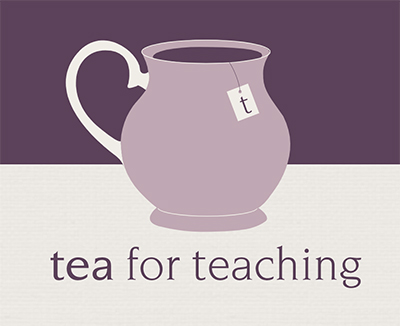Murph Kinney
There’s an elephant in the room. At least in my room: burnout. Before this particular semester, I was invariably excited about the start of classes—what new students will come my way? How will I use a new technique? What sort of tips will I pick up from speaking with my colleagues? One of the reasons I love this profession is that it affords us opportunities to begin anew twice a year. One new resource I’ve found that both helps me both combat burnout and think more deeply about my online teaching practices are podcasts. I am late to this genre, but recently I’ve committed to listening to several episodes a week, in part because it helps me feel connected to a world of teaching and learning that has seemed distant since we moved to remote instruction last March. In particular, I’ve come to appreciate the Tea for Teaching podcast, hosted by economist John Kane and Rebecca Mushtare, a graphic designer, who together run the Center for Excellence in Teaching and Learning at SUNY Oswego. Their podcasts are produced weekly and feature interesting guests who speak on timely issues. Each podcast is about 30 minutes. Listening to their podcasts is like sitting in a coffee shop, joining in a wide-ranging conversation with smart and funny colleagues, generous with their time and attention. While all of their podcasts are good, there are two I’d recommend giving a listen to now. Perhaps unsurprising, given my introduction above, the first is on faculty burnout and student burnout, and how to graciously deal with both: January 20, 2021, podcast. This episode’s guest is Dr. Rebecca Pope-Ruark from Georgia Tech’s Center for Teaching and Learning, the author of several books on balancing work and life for faculty. Pope-Ruark discusses what burnout is, offering an excellent comparison between regular stress and burnout, allowing the listener to evaluate what sort of challenges he or she is facing. She discusses exactly how the pandemic is affecting faculty, particularly given the move to remote instruction. And while I knew much of this, I found her discussion useful because it validated my own experience as well as putting it into a larger context. Even more important was Pope-Ruark’s suggestions about how to handle student issues. In spring 2020 and fall 2021, I was fielding emails from students sharing deeply personal and deeply distressing problems like domestic abuse, the death of a parent, EMT burnout, most with graphic descriptions. As faculty, we are increasingly getting emails like this, but we, by and large, are not trained to handle this emotional burden. Pope-Ruark describes how to take care of ourselves around disclosures like these and how to direct students to offices and agencies that are equipped to assist them. The other episode I recommend is about equity in online courses: January 27, 2021, podcast. This podcast features guests Dr. Kevin Kelly and Dr. Todd Zakrajsek, who co-authored a book on creating equity-based digital learning environments. Instead of looking at technology, Kelly and Zakrajsek focus on the human element in designing online courses. Many of us may have heard of Universal Design for Learning (UDL), which means engineering a course so that all students have equal opportunity to succeed. In this podcast, Kelly and Zakrajsek discuss why that is particularly important for the students we now have in our online classes: students who may not have access to laptops but who do much of their work on phones or tablets. They give several reasonable solutions to the questions of what we as instructors can do to lessen the divide between students who have access to laptops and stable internet connections and those who are more precariously positioned in terms of access to technology. Kelly and Zakrajsek also suggest concrete measures to lessen the cognitive load for our students. Scaffolding assignments—breaking them into manageable chunks—is one way. Providing start dates for assignments rather than just due dates is another. (Based on this suggestion, I uploaded a video at the start of this semester, with a suggested weekly work flow, showing when to begin reading the material, when to draft discussion board posts, and when to actually post and respond. Initial feedback from students was encouraging, with a number of students mentioning that having a specific timeline was helpful.) For more of those suggestions, all evidence-based, give this podcast a listen. Finally, speaking of cognitive load, many students nationwide are reporting a perceived increase in course workload. The Chronicle of Higher Education ran a piece about that earlier this month. It is a good read in its own right, but embedded in it is a useful tool, a new student workload estimator that assesses how much time students need to spend in a particular online class given the readings, assignments and discussions. I’d suggest using it to evaluate the courses you’re teaching. The results may surprise you. That elephant in the room—burnout? It’s still here. But we will make it through. Together. As always, I’d appreciate your comments and suggestions. Reach me at kinneym@sunysuffolk.edu. |
